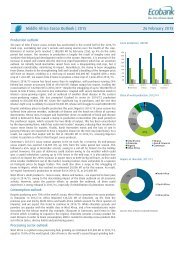www.ebook777.com
Make_Getting_Started_with_Processing_Second_Edition
Make_Getting_Started_with_Processing_Second_Edition
Create successful ePaper yourself
Turn your PDF publications into a flip-book with our unique Google optimized e-Paper software.
y = height/2;<br />
}<br />
void draw() {<br />
x += random(-speed, speed);<br />
y += random(-speed, speed);<br />
ellipse(x, y, diameter, diameter);<br />
}<br />
If you watch this example long enough, you may see the circle<br />
leave the window and come back. This is left to chance, but we<br />
could add a few if structures or use the constrain() function to<br />
keep the circle from leaving the screen. The constrain() function<br />
limits a value to a specific range, which can be used to keep<br />
x and y within the boundaries of the Display Window. By replacing<br />
the draw() in the preceding code with the following, you’ll<br />
ensure that the ellipse will remain on the screen:<br />
void draw() {<br />
x += random(-speed, speed);<br />
y += random(-speed, speed);<br />
x = constrain(x, 0, width);<br />
y = constrain(y, 0, height);<br />
ellipse(x, y, diameter, diameter);<br />
}<br />
The randomSeed() function can be used to force<br />
random() to produce the same sequence of numbers<br />
each time a program is run. This is described further<br />
in the Processing Reference.<br />
Timers<br />
Every Processing program counts the amount of time that has<br />
passed since it was started. It counts in milliseconds (thousandths<br />
of a second), so after 1 second, the counter is at 1,000;<br />
after 5 seconds, it’s at 5,000; and after 1 minute, it’s at 60,000.<br />
We can use this counter to trigger animations at specific times.<br />
The millis() function returns this counter value.<br />
Motion 111



